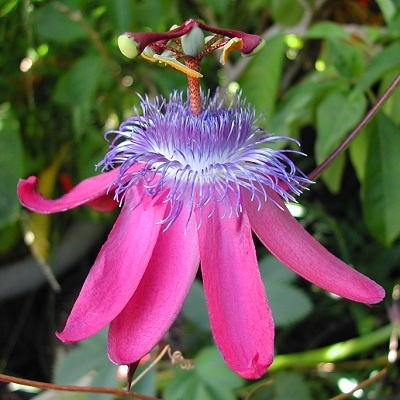Germinating the seeds
When to plant -- Stored seeds don't germinate well, so plant your seeds when you receive them for best results. Getting started -- Soak your seeds for about 24 hours a cup of water. Soil -- Use a soil high in organic matter but that also drains well. A typical mix is 2 parts potting soil to 1 part perlite or coarse horticultural sand. Pot size - You may use small pots about 3 or 4 inches tall (7-10 cm) and 2 to 3 inches (5-8 cm) wide. Fill the pots with the soil mix, place a seed on top in each pot, and cover with about 1/4 inch (7 mm) of soil. Add water until even moist (but not saturated). Until the seeds sprout, ensure that the surface soil doesn't dry out. If you place the pots in a plastic container or bag to maintain moisture, leave it open slightly to allow fresh air in. Temperature -- Aim to keep them between about 68 and 78° F (20-26°C) during the day, and between 58 and 75°F (14-24°C) at night. I recommend placing a minimum/maximum thermometer near the pots. Keep them in a bright spot out of direct sun. They can take anywhere from 1 to 3 months to sprout. Lighting the seedlings -- Once your seeds sprout, move them to a bright spot, with protection from strong sun. You may use a bright LED light kept a few inches (10 cm) away while your plants are young (See: Growing indoors under LED lights). Watering: Once the seedlings are 3 weeks old, you may allow the surface soil to dry out, but aim to keep the rest of the soil evenly moist most of the time. Never let it dry out completely, but also don't keep it constantly soggy. Fertilizing -- I recommend feeding with a small amount of dilute (1/8 strength) liquid fertilizer when the seedlings are a week old. Hydroponic fertilizer is ideal for young seedlings, since it is easily absorbed and contains all essential nutrients. Repeat the feeding every 2 weeks 3 more times. After that, you may switch to a granular fertilizer that contains micronutrients, following the dosage on the package. Growing onward... Climate -- Older plants do well between 40 and 85°F (5-29°C). I have no information about how it does outside that temperature range. I suggest protecting it from frost. Over about 40% humidity is recommended. Lighting -- Adult plants like part-sun. They may need some shading from strong afternoon sun, especially in warmer climates. Repotting -- Once your seedlings are at least 3 inches tall (7 cm), you may repot them to larger containers about 1 quart (1 liter) in size. Repot gently and avoid letting the soil ball break apart. The first week after repotting, shade from sun and give no liquid fertilizer. Repot again after 4 to 6 months. The final pot size depends on how large you choose to let it grow, with a 10 gallon (40 liter) pot being suitable for an unpruned plant. You may prune your plant to any size that is convenient. General tips about this plant. If you have any questions or problems, please contact me. Have fun growing them! - Jeff Strange Wonderful Things
|
|||||||||


